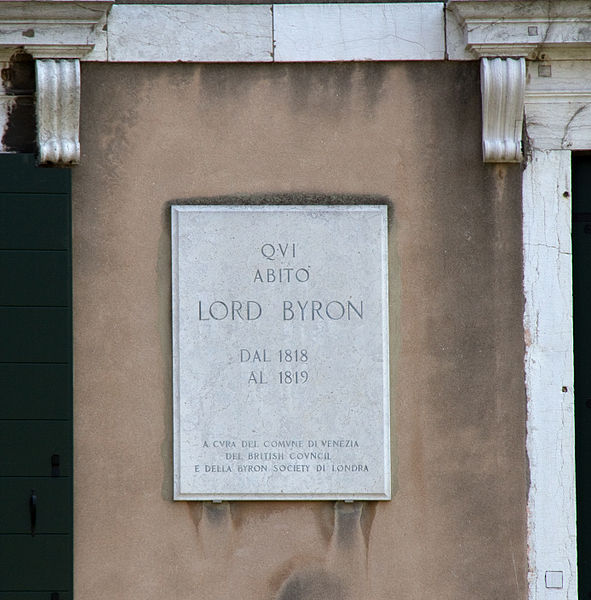
October 3, 2014, by Harry Cocks
Byron in Venice
Lord Byron’s reputation as the quintessential romantic hero – brilliant, seductive, cosmopolitan, ironically humorous, and a little dangerous – is well established. In a new article (see link below), David Laven of Nottingham History argues that this persona was very much his own creation. During his stay in Venice between November 1816 and December 1819, Byron’s correspondence with his English friends helped to produce this version of himself. As Dr Laven points out, the poet’s biographers since Moore (1830) have accepted Byron’s own version of his life in Venice more or less at face value. While his correspondence, poetry and plays suggested his full immersion in Venetian life, Dr Laven suggests that in his actual interactions with Venice, Byron remained at its margins, spending most of his time with his fellow-countrymen (when he wasn’t engaging in esoteric pursuits such as unsuccessfully trying to learn Armenian), and taking little interest in its art or architecture, or in its contemporary political and economic situation. In fact, Byron’s chief form of interaction with Venice was through the compulsive pursuit of sex, usually bought from the local prostitutes. In his letters home, he claimed to have bedded 200 women in Venice, in the process spending more than £2000. At the time of his residence there, Venice was going through a serious economic crisis, so it was not difficult to seduce the locals with cash. The poet Shelley, visiting Byron in 1818 wrote that the poet’s Italian women were hardly the elegant courtesans he described, and were in fact “perhaps the most contemptible of all who exist under the moon – the most ignorant, the most disgusting, the most bigoted.” Byron claimed to have embraced la Serenissima and its culture, but, Laven argues, his relationship with the city was fundamentally “based on exchange.” In that sense, he established a precedent for future British literary visitors like John Addington Symonds and Frederick Rolfe, who, while romanticising the city and its people, copied Byron’s pattern of sexual imperialism (albeit in homosexual terms). They took local lovers, convincing themselves that this was a relationship of equality, while all the time it took place in the context of payment and patronage. The “acceptance of the Byronic myth,” Dr Laven says, “effectively legitimated sexual tourism … in which visitors with superior education and wealth imitated Byron in taking advantage of locals, whom they paid for sex, but whom they subsequently sentimentalized and idealized in their writing, justifying the purchase of sex as a means of buying not just physical pleasure, but also of getting closer to the city and its inhabitants.” David Laven, ‘Sex, self-fashioning, and spelling: (auto) biographical distortion, prostitution, and Byron’s Venetian residence’ in Alan Rawes & Mirka Horová (eds) “Tears, and tortures, and the touch of joy”: Byron in Italy, Litteraria Pragensia, 23:46 (2013), 38–52 http://litteraria-pragensia.ff.cuni.cz/front.issue/detail/48

Very good Post !